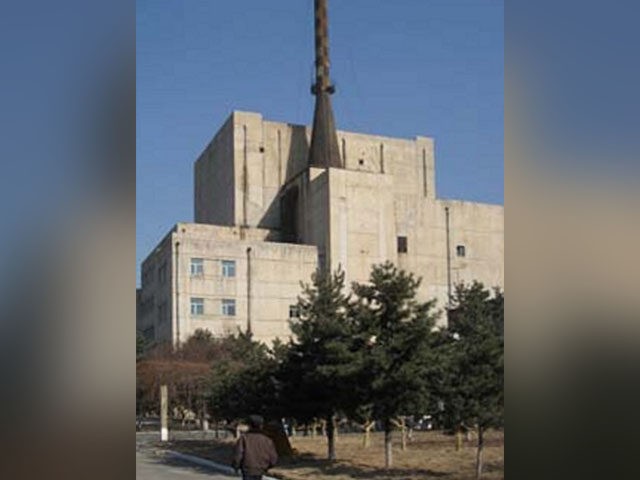The North Korea monitor site 38 North revealed on Thursday that satellite images suggest significant flooding at the Yongbyon Nuclear Scientific Research Center, a facility believed to be used for uranium enrichment, that may have “exposed how vulnerable the nuclear reactors’ cooling systems are to extreme weather events.”
38 North published before-and-after comparisons of the height of the Kuryong River along the complex showing much of the riverbank that would be traditionally exposed now underwater.
“Although the security wall around the reactor complex was not breached, the water had reached the two pump houses that service the reactors and completely submerged their respective bases,” the site concluded. “The overfall dam that was built to ensure a constant reservoir of water and is available for cooling the reactors was also fully underwater.”
The site concluded that the damage was “the worst in the past several years” but that no signs indicated the facility used to enrich uranium experienced any harm. The most water appeared to flow in images from August 6 and, by August 11, the waters seemed to have receded, “suggesting that the major facilities within the complex, such as the Uranium Enrichment Plant (UEP), have been spared.”
Experts believe the site features two key types of nuclear technology: uranium enrichment tools, which extract fissile isotopes from unprocessed, stable uranium, and at least two nuclear reactors, which trigger fission and generate energy. The Yongbyon site is believed to have been used to generate the highly radioactive plutonium used in nuclear weapons the communist regime previously tested. Nuclear reactors require pools of water to use for cooling to prevent meltdowns. The worst damage from the floods, 38 North noted, may have occurred to the pumps that feed the cooling systems.
“Damage to the pumps and piping within the pump houses presents the biggest vulnerability to the reactors. If the reactors were operating, for instance, the inability to cool them would require them to be shut down,” 38 North explained. “And while the river waters may recede rapidly, if damaged, the pumps themselves could be out of service for some time, depending on their level of damage and whether replacement parts were readily available.”
The water did appear to reach two pump houses.
The South Korean Defense Ministry, which typically monitors North Korean nuclear activity, declined to comment on 38 North’s observations, which were based on commercially available satellite images. The South Korean news agency Yonhap reported that a spokesperson for the ministry offered reporters a general statement on Thursday affirming, “Our military is always closely monitoring the North’s nuclear and missile activities, and the authorities of South Korea and the United States are keeping a close cooperation system.”
North Korea has experienced intense rainfall in the past week, as has much of east Asia. The floods in the communist country follow over a month of devastating flooding in China, affecting 27 of that nation’s 31 states and distorting the structure of the Three Gorges Dam, the largest hydroelectric plant in the world. The floods in China have inspired global concerns over food safety in the much larger and wealthier communist country, suggesting a similar natural disaster could cause much more humanitarian strife.
North Korean state media has admitted to the flood damage in laudatory reports detailing the aid that communist dictator Kim Jong-un is reportedly offering the affected.
“Great loving care of Supreme Leader Kim Jong Un who prioritizes safety and happiness of people and spares nothing for them has reached people in the flood-hit area of Unpha County,” the state-run Rodong Sinmun newspaper reported on Monday. Kim allegedly visited affected areas personally and”took measures to promptly bring the living of inhabitants to normal on the dangerous spot inundated by flood.”
Kim’s on-site visit, if true, means that the dictator reached out to his subjects quicker than his communist counterpart Xi Jinping in China, who has yet to visit flooded areas.
Rodong Sinmun claimed that Kim had “sat up all night, not relieved” waiting to visit the victims of the flood and did so with several communist officials, who regaled the locals with a day of ideological speeches.
“Trucks carrying grain arrived at Unpha County on Sunday morning,” the newspaper alleged, adding that the victims received the “grain of love” and were “greatly moved and excited to tears.”
On Wednesday, state media claimed another shipment of “essential materials” reached flood-affected areas.
The Yongbyon nuclear complex is one of the regime’s most prized facilities, as it is capable both of generating nuclear energy for commercial use and generate weapons-grade material. In July, 38 North reported that satellite images suggested that, despite making a vow to “denuclearize,” Kim had not halted nuclear activities at the site.
“Commercial satellite imagery over the past year indicates that the light activity observed throughout North Korea’s Yongbyon Nuclear Scientific Research Center goes beyond a caretaker status,” 38 North observed. “Caretaker” activities would be those that ensured only that, if need be, the site could return to regular use immediately. The trafficking of apparent chemicals into and out of the site suggested “continued enrichment operations,” 38 North posited.
North Korea claimed to have shut down another nuclear site — the Punggye-ri Nuclear Test Site, where it detonated several of its experimental nuclear bombs — in the aftermath of the first in-person meeting between Kim and President Donald Trump in 2018. The video of officials destroying the site left many experts unconvinced that it is no long able to operate if North Korean scientists wished to activate it.

COMMENTS
Please let us know if you're having issues with commenting.